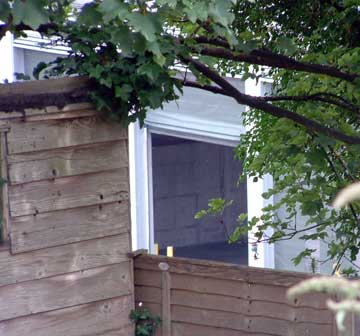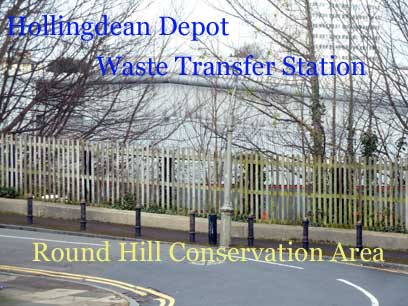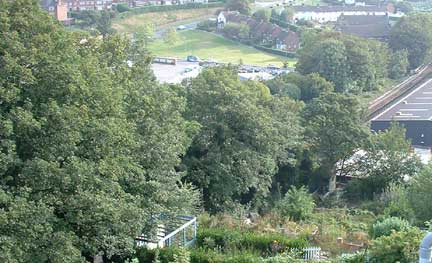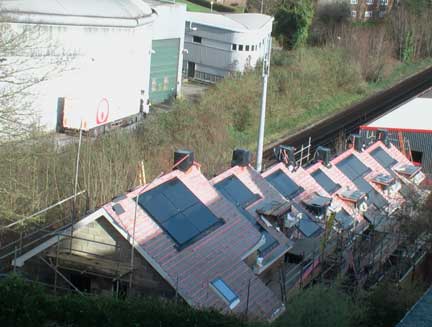This page is from the Round Hill Society archives which are available for historic interest. Please bear in mind when viewing archived pages that details may no longer be current.
Veolia 2016 Say No to industrial waste
Brighton and Hove City Council jointly prepares the Waste and Minerals Site Plan with East Sussex County Council and the National Park Authority. Specific areas of land are then allocated where it is considered that the management of waste and production of minerals could take place in the future to meet identified needs.
The purpose of the site plan was to identify existing waste management facilities which could be developed to help to meet the need for an additional recycling and recovery capacity between 2013 and 2027.
Hollingdean Depot currently handles domestic waste only, but the above plan floats a proposal (which could be followed by a planning application) to extend the site's use to commercial and industrial waste.
Public consultation on this has already been completed. However, the responses to public concerns show a disappointing lack of sensitivity to the nuisances which immediate neighbours already suffer. See representations and officers' responses made during a public consultation (4 July 2014 - 5 September 2014) on identifying sites for waste. Contrived to serve a cost-cutting idea of combining collections of domestic and industrial waste, these are not evidence-based responses to public concerns. They pervert the proximity principle by overlooking the reality of a poorly located and inadequately landscaped site containing buildings (WTS and MRF) unfit for purpose:
- of inadequate design to contain the odour of rotten food waste - the reality is that wafts of it regularly pervade Round Hill
- too basic in construction to prevent nuisance from industrial noise regularly compromising nearby residents' enjoyment of their homes and gardens.
Fugitive emissions & our homes / gardens
Independent Assessment of dust escapes from the cheaply constructed Waste Transfer Station is long overdue:
We have had noise impact assessments - accompanying planning applications [i] to build new homes even nearer than existing ones to a Municipal Dump not known for offering reasonable tranquillity [ii] to extend the operating hours of both The Waste Transfer Station and Materials Recovery Facility to 7am to 10pm on 363 day in the year, removing periods of respite from the noise.
However, no assessment of the level of fugitive emissions has been performed and results communicated to nearby residents on how much extra dust is getting into our homes / gardens / eyes since operation of The Waste Transfer Station commenced in 2009. Permission was given in 2006 and the construction process which followed also kicked up a lot of dust before the city's output of domestic waste (+ more from other areas of the SE) arrived.
[FACT 1] The Waste Transfer Station lacks the quality of design (e.g. double doors) sufficient to prevent escapes of odour particles regularly carried into Round Hill by the wind.
[FACT 2] Intermittently, industrial cleaning takes place outdoors at the southern perimeter of the Waste Transfer Station and Hollingdean Depot site - I'm afraid to our displeasure with regard to noise.
So here is the question which needs to be answered through independent investigation whether or not it is also posed as a freedom of information request to Brighton and Hove City Council (Veolia's main Hollingdean Depot client):
How much dust is crossing the perimeter fence into Round Hill gardens? The intermittent use of an industrial vacuum cleaner in an outdoor yard would scarcely influence this.

The main doors of Brighton and Hove's Municipal Waste Transfer Station at Hollingdean Depot (pictured in the background) are within 100M of several residential properties within The Round Hill conservation area.
Can our universities help RE dust escapes?
Several students from the universities of Brighton and Sussex lodge in & around the Lewes Road valley / the academic corridor quite near to Hollingdean Depot. Initiatives such as the Community University Partnership Project link the welfare and education of students and other local residents. Moreover, certain university departments focus on scientific & health issues such as air quality and may have a direct interest in funding projects where the principles of measuring emissions can be applied in the very environment where their research students live.
One might expect The Environment Agency, which grants Veolia's permission to operate, to research this as part of monitoring fugitive emissions - a category within the operating licence. However, if cuts to The Environment Agency 's budget limit them mainly to a complaint-led approach to monitoring, then those departments within our city's universities (Sussex / Brighton) which focus research on "the measurement of air quality" might be persuaded to assist in "what is clearly a matter of public interest to Hollingdean Depot's immediate neighbours".
Round Hill residents who suspect that (a) they are getting high levels of dust in their eyes when out in their gardens and that (b) the benefits of window cleaning have been short-lived since the major changes of use at Hollingdean Depot, would like honest answers.
No Waste and Minerals Plan for any city can be properly informed without these answers. The research needs to be independent and findings need to be made known to the people who are most closely affected by the results.
Below are the representations made during a public consultation (4 July 2014 - 5 September 2014) on identifying sites for waste. The representations below all address the unsuitability of the Hollingdean Depot site for doing the extra job of processing commercial and industrial waste.
[ Representation IDs are given below in the form PS** ]
Representations and officer's responses
SOURCE: pages 18 and 19 of the following document -
- Waste and Minerals Sites Plan – Summary of Representations 2014 (Oct 2015) (PDF) (Size: 74MB)
PS25 PS70: Air Pollution - Area suffers from air quality issues. Waste development and associated traffic would unacceptably exacerbate issue.
Response: It is noted that an AQMA (Air Quality Management Area) is located along Hollingdean Road to the east of the site and on Lewes Road. Routeing arrangements could minimise distance HGVs travel within the AQMA. Site is an existing industrial area - waste management uses may not have a materially different effect on the AQMA compared to other industrial uses.
__________
PS70: Business Amenity - Waste management development would have an adverse impact on existing local businesses located on the site.
Response: Modern waste management facilities are often housing within buildings and can be indistinguishable from other light industrial uses. Co-location with existing waste management facilities on the site could provide benefits.
__________
PS25: Existing Noise - The existing site generates unacceptable noise.
Response: The WMSP deals with providing potential sites for new waste management facilities – it is not concerned with the operation of existing facilities. However, the level of additional noise would be considered in the determination of a planning application, should a develop submit one wit the intention of developing a new facility on the site.
_________
PS25: Existing Odour - The existing site generates unacceptable odour.
Response: The WMSP deals with providing potential sites for new waste management facilities – it is not concerned with the operation of existing facilities. However, the level of additional odour would be considered in the determination of a planning application, should a develop submit one wit the intention of developing a new facility on the site.
_________
PS25, PS70: Site is unsuitable for waste use due to proximity to residential properties.
Response: The potential for effect on residential amenity was considered during the site assessment process, with the conclusion that the site graded as medium, which means “There is the risk of significant harm but mitigation measures could reduce risk to acceptable levels. The residual risk of harm may be acceptable when weighed against benefits.”
_________
PS25, PS70: The site is busy and on a walking route for school children. Additional vehicles would be dangerous.
Response: The level of traffic that could be generated would only be known once a proposal for a scheme is submitted to the Council. Full consideration of the impacts of the increase in traffic movements would then take place as part of the determination of the planning application.
_________
PS25: Concern that an increase in the number of traffic movements or the type/size of vehicles will have an adverse impact on local community.
Response: The retained allocation is further aware from the schools than the existing waste transfer station. Notwithstanding this, any proposed facility would need to be designed to a high standard with appropriate mitigation measures to reduce potential adverse impacts on the surrounding area to an acceptable level.
________
PS25: The Dump the Dump campaign responded to the original proposal for a waste site in the above location to be managed by Veolia. The document submitted by the residents campaign effectively pointed out all of the problems with the proposal in a well-argued and well evidenced manner. Among the issues that their report raised was the concern that once a contract was signed with Veolia it would only be a matter of time before Veolia applied to expand the operational hours and to extend the operation to process commercial and industrial waste on the site that was not fit for purpose. In mitigation of the detrimental effects on the area the council responded that under no circumstances would the hours of operation be increased and under no circumstances would the site be used for commercial and industrial waste. The operational hours have subsequently been increased and now we are told that commercial and industrial waste is being considered for the site. The people of Hollingdean have been sadly let down and will suffer further if this new proposal were to go ahead.
Response: The Waste Minerals Sites Plan consultation does not relate to the operation of the existing Veolia facilities on part of the site. The purpose is to consider whether the remainder of the site should continue to be allocated for waste management development. There is no specific proposal. For further development on the site. For further development to occur, a waste management company would need to submit a planning application would be subject to the usual process with full opportunity for public consultation.
_____________
PS25: There is no need to repeat all of the evidence and all of the arguments that were detailed in full in the Dump the Dump report as the Council have them.
Response: The Dump the Dump campaign related to a planning application for specific waste management facility. The Sites Plan merely allocates a site which could potentially be suitable for waste management development. Until a scheme is proposed for the site it is not possible to make detailed judgements about the impacts of a new facility, as the technology and size are uncertain.
_____________
PS70: The consultation period seems deliberately designed to exclude comment from users of Downs Infants School and Downs Junior School due to the summer holidays.
Response: The consultation ran for a period of nine weeks from 4th July to 5th September 2014.
____________
PS70: The opportunity to use rail transport from the site has been excluded by previous developments. Site does not provide an opportunity to transport waste and minerals by a low carbon method.
Response: The site assessment concluded that a rail connection was unlikely to be feasible as although the railway is adjacent, it is raised on an embankment.
________
Hollingdean Depot - Waste Site Profile
Source: page 47 of the following document:
- Download the Draft Waste and Minerals Sites Plan (PDF)
WMSP-A/E Hollingdean Industrial Estate, Brighton
Description
This is an existing site allocation in the Waste Local Plan 2006. The southern part of the allocation has been developed as a Waste Transfer Station and Materials Recovery Facility and the site boundary has therefore been amended to exclude this part of the original allocation. Northern part remains in use as small older industrial units and a Council depot.
Other Information
Part of site is an existing waste site: Hollingdean Depot.
Site allocated in Brighton and Hove City Council's Submission City Plan Part One 2013, Policy CP3(3).
Site allocated in Brighton and Hove City Council's Local Plan 2005 (Adopted), Policy EM1 - Hollingdean Industrial Estate.
Constraints
The following constraints may need to be considered:
- Proximity to Local Wildlife Sites and / or Local Nature Reserves
- Site contains or is close to Biodiversity Action Plan species, habitats or wildlife reserves; Proximity to Conservation Areas and/or Listed Buildings;
- Proximity to un-designated heritage assets and areas with potential for archaeological interest; Site and / or traffic from site may affect an Air Quality Management Area; Proximity to residential properties;
- Landscape/townscape character and visual amenity;
- The existing uses on the site, and those surrounding it;
- Site is within Groundwater Protection Zone 3;
- Site access and / or capacity of surrounding transport infrastructure;
Opportunities
The following opportunities may be present at this site:
- Potential to connect to major heat users;
- Potential to connect to national grid connection;
- Opportunity for co-location of waste management facilities;
- Opportunity for utilising sustainable modes of transport (rail and/or water);
- Located on previously developed land;
- Located on land identified for industrial use;
Hollingdean Depot - Sustainability Appraisal
Source: page 48 of the following document:
Summary
Development on this site is likely to have a positive effect on the minimisation waste generation and disposal to land; and causes of and our adaption to climate change. It may have minor positive effect on employment opportunities and developing and maintain a skilled workforce.
Development on this site, without mitigation, may have a negative effect on air quality and air pollution; and biodiversity and geodiversity. Depending on the detail of any development it may also affect the amenity of residents and neighbouring land uses; the sustainable use of local mineral resources; water quality; the impact of transporting waste and minerals on the environment; soil quality and functions; the historic built environment and countryside; increasing energy efficiency and the proportion of energy generated from renewable sources; and the growth of a sustainable and diversified economy.
Habitats Regulation Assessment Summary
Waste management development would not lead to likely significant effects on European sites, subject to them not being delivered as EFW facilities.
A Round Hill resident's response
No political will to respond to the evidence
View a letter to Round Hill residents from the investigating officer of the government's Environment Agency confirming the reality of the problems bulleted near the top of this page. These nuisances remain with us and it has not been possible to mitigate the consequences of poor design unfit for purpose in an unsuitable location.
Meanwhile, staffing levels at the Environment Agency have been cut, so it needs a minimum of 3 complaints a day for them to come out and investigate. Residents who do complain often feel isolated, as if there is no political will to provide them with a reasonably clean and dust-free environment without regular exposure to wafts of odour and industrial noise.
Visual impact on conservation area Landscaping south of Waste Transfer Station stripped away 
Normally, you would expect planning conditions to require more landscaping when a Waste Transfer Station is sited next to a residential community. Most developers (other than Veolia applying on behalf of Brighton and Hove City Council) would be required by Brighton and Hove City Council to provide adequate landscaping within their own site. i.e. not to rely on a thin line of trees well outside the site which do not form an adequate screen in winter months.
However, too much has been crammed onto the Hollingdean Depot site to allow mitigation for loss of visual amenity experienced by people living in or passing through The Round Hill Conservation Area. Siting both an enormous MRF and a WTS (so basic in design that it was destined to pollute) on this limited site against the advice of the plannig inspector who conducted the Public Enquiry, left no space for landscaping within the southern perimeter.
Far from "protecting and enhancing", the 2006 permission created "the monster in our midst" which the Waste Authority is now looking to for cost savings by floating the insensitive proposal to use a noisy, smelly and unsuitably located site for commecial and industrial waste as well as all the city's domestic waste.
Below was the screen of trees which separated Round Hill from the industrial Hollingdean Depot site over 10 years ago.
We now look out onto an industrial yard, though 6 new homes have been added to the plot (visible from homes to the NE of Princes Road) in the foreground (compare pictures above & below).
The industrial eyesore of the Waste Transfer Station is also visible from public streets at the NE end of Princes Road i.e. the north end of Mayo Road. Wafts of odour regularly greet residents as they open their front doors in these streets. It is easy to see where they are escaping from.

It is certainly true that Hollingdean Depot is already an industial site. It is already noisy and smelly, compromising the amenity of residents in nearby homes and gardens. Is the proposal for extra waste processing functions within this unsuitably located site - not to mention extra numbers of Heavy Goods Vehicles on the Hollingdean side - really something that the Waste Authority can promote with a clear conscience?
Thousands of objections were ignored when the 2006 permissions for domestic waste facilities were granted, though this was costly in votes to the parties which voted this troublesome Dump through. I would hope that it proves difficult for Councils to ignore "people power" for ever, even though it is difficult for democracy to thrive in cash-strapped times. It was encouraging recently that public response contributed to a retreat by the current administration from the proposal to cut City Parks Rangers from 9 to 3.
Gross failure to monitor "escapes of dust"
Proper monitoring of the level of dust escapes is long overdue and needed now to provide reassurance to people living within 100 metres of Hollingdean Depot. The inadequacy of the design of the Waste Transfer Station to contain the particles which carry odour, makes it highly probable that a lot of dust is escaping from what should be a sealed environment. Fugitive particles (i.e. escapes of dust) are a known drawback of siting Waste Transfer Stations near to people's homes and gardens.
Although Veolia cleans their own yard (and subjects us to a lot of high-pitched humming in doing so), their industrial cleaning equipment does not clear particles which have already crossed into our gardens. Sealing the outdoor perimeter of their site is impossible, so it is unacceptable cost-cutting which has resulted in a cheap design of Waste Transfer Station building. In the absence of double doors (like the courtesy doors one would expect in a public toilet), the frequent opening of Veolia's doors makes the spread of dust and dirt (from an installation which is far smellier than a public toilet) inevitable.
We notice how quickly windows to the rear of our home (facing Hollingdean Depot) become dirty again after they are cleaned. We have pondered on whether employing a window cleaner is worthwhile when the benefits of clean panes last for so little time. Although waste processing (in buildings unfit for purposes requiring a sealed environment) isn't the only cause of poor air quality, it would be reassuring to see some professional assessment on the contribution of Hollingdean Depot to increased dust in the neighbouring environment.
Industrial waste and particulates e.g. PM2.5s
Adding to harm done by fugitive particles - the present level of which remains unmeasured - by including commercial and industrial waste in the mix, would heighten our health concerns.
Reasons for these concerns were given to us as early on as 19th July 2006, by Dr Dick van Steenis who highlighted the risks of particulates, especially PM2.5s which are small enough to get into people's breathing tubes, as well as PM2s which can reach into the bottom of people's lungs.
Platitudes such as "perception of noise and odour is subjective - please rate on a scale of 1 to 6" are lame justifications for a complaint-led system of monitoring pollution from Hollingdean Depot.
A perversion of "The proximity principle"
Risking residents' health through absence of routine procedures to monitor escapes of dust (fugitive particles) into neighbouring homes and gardens, is something which should be of concern to the Health Authorities i.e. a gross abdication of duty. Meanwhile, cuts are continually made to staffing levels at the government's Environment Agency, the body which gives Veolia its licence to operate. Rather than monitoring existing escapes contributing to poor air quality, officers within Waste Authorities are looking for new ways of delivering an important service on the cheap at the cost of people who live nearest to unsuitably located Waste Transfer Stations. This is a perversion of what is glibly referred to by waste planners as "the proximity principle".
Questions for The Environment Agency: 0800 80 70 60 (complaints)
- on a scale of 1 (low) to 6 (high), how would you rate *the design* of The Hollingdean Depot Waste Transfer Station as capable of providing a sealed environment to minimize escapes of odour and dust (fugitive emissions)? See the nuisances you purport to monitor in your operating licence.
- Is your level of government funding sufficient to allow you to operate an accreditation system which would allow "suitability of building design" (among the Waste Transfer Stations you license in England and a small part of Scotland) to be compared? Are league tables for environmental health and good design practice being given lesser or greater priority than league tables for education? Is government leading by example?
- Are changes in funding from Central Government making it easier or more difficult for you to do "more than just complaint-led monitoring" to ensure that the facilities you license are not an ongoing source of unreasonable nuisance to residents living near them?
Related articles
- Life near The Dump - what is "living in the vicinity of a Waste Transfer Station" like?
- Life fighting a proposed dump - Round Hill Brighton is not alone in resisting unreasonable waste disposal schemes. See how The Pinkham Way Alliance, a group of North London residents, resisted a proposed Waste Transfer Station.
- Going for the burn [The Guardian 22-02-2006] on the harm done through the incineration of waste.
- Dr Dick Van Steenis - the incineration of waste